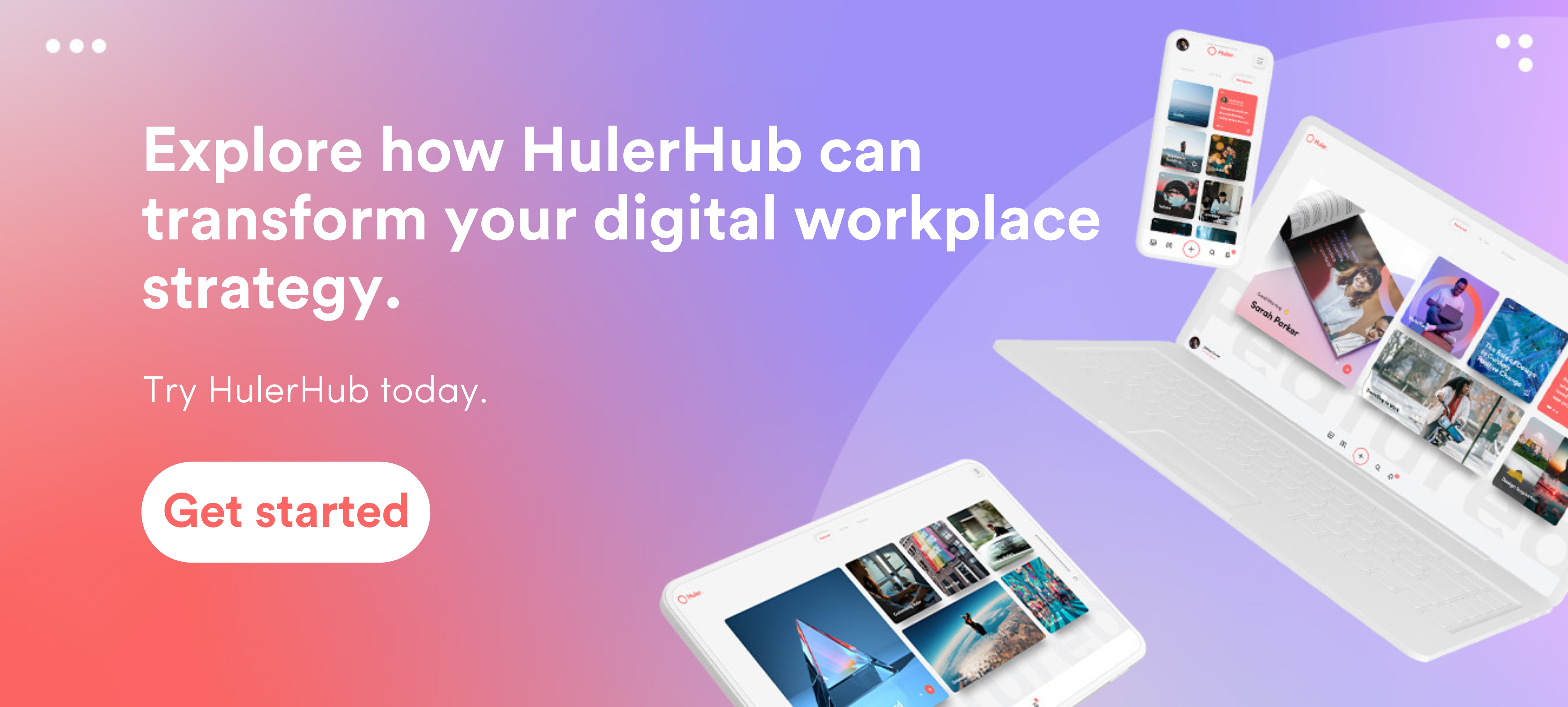The digital workplace has recently been hailed as a solution to many of the problems that plague traditional workplaces, such as lack of collaboration, low engagement, and inefficient processes. This in part, because our ways of working have changed dramatically since 2020, and digital adoption has moved forwards much faster than we could have hoped or planned for.
As technology becomes more sophisticated, it is getting easier for people to work from anywhere, rather than being shackled to the confines of a specific location. But to make work from anywhere and hybrid working models successful, companies now need to implement a solid strategy that will allow their employees to work flexibly and make the most of the technology they already have, while boosting productivity and engagement.
Digital workplace strategies are one way for these organisations to keep pace with these new ways of working while maintaining (or even improving) business processes and employee experience. In this article, we’ll explore what these strategies are and how they can be implemented effectively.
What is a digital workplace strategy?
A digital workplace strategy is a plan designed to create an effective digital working environment for employees, whether they are based remotely or otherwise. These strategies focus on the use of technology, including appropriate hardware and software, to improve the efficiency of an organization’s business processes and boost employee engagement.
A digital workplace strategy is where digital transformation and employee engagement intersect to ensure your people aren’t alienated or overwhelmed by complex, disparate systems that don’t play nicely together. Instead, they are empowered to work efficiently, creatively and productively with the help of the technology at their fingertips.
To learn more about digital workplaces, read our blog: What is a Digital Workplace?
Why is a digital workplace strategy important?
A digital workplace strategy is important because it helps businesses to create the best possible work environment for employees and the best experience for customers. In fact, it has been proven that companies who have embraced digital workplaces and transformation are more competitive, grow quicker and have higher productivity rates than those who have not.
Crucially, though, digital workplace strategies are so important because they provide a solid plan for how your business is going to use technology to its advantage both now and in the future. In the immediate term, they help you to understand the full potential of your current technology investments in relation to efficiency, productivity, flexible working practices and culture. In the long term, they also help you to spot emerging opportunities that will put your company one step ahead of the competition.
Take a moment to think of all the technology your business has invested in, adopted and accrued over the last few years. Do you think that it is all being used to its full potential? If not, then it’s probably time to consider (or reconsider) a digital workplace strategy in order to:
- Refine and streamline business operations
- Boost employee engagement
- Improve communication
- Increase agility
- Prioritise security
- Enable flexible working
- Improve the customer experience
- Encourage collaboration
How do you create an effective digital workplace strategy?
The key to creating an effective digital workplace strategy is to ensure that your workplace is designed to meet the needs of all employees and your business goals. This not only includes what workers need to do their jobs well, but also what they want and need in order to be productive and feel engaged.
Take a moment to assess where your business is now in terms of digital workplace transformation, as well as your goals for the future. What challenges is your business facing? Are there any processes that are holding you back? Do your employees come up against the same problems every day and lose time because of them?
These are just some of the questions you will need to answer before fleshing out or implementing a strategy. Because, at the end of the day, your digital workplace strategy should be designed to address these pain points head on. But don’t just answer them yourself, get your ear to the ground and work closely with your people to really understand their unique needs and challenges.
Then, when it comes to creating your strategy, there are five main pillars to consider:
- Technology
- Content
- Collaboration
- Compliance
- Experience.
Let’s look at each in detail.
Technology
The technology that employees use at work should be intuitive and help them to complete their day-to-day tasks. It should also keep them connected and enable them to work more productively in collaboration with colleagues.
Digital transformation and workplace strategies aren’t about burning your current setup to the ground and starting again. Nor are they about reinventing the wheel. Rather, your digital workplace strategy should identify ways to simplify how you work, add value to the customer experience, or improve the employee experience based on the work tech you already know, use and love.
Everyone in your business uses technology in some way, shape or form in the course of their work. This could be software that has been officially implemented (such as CRMs or intranets) or unofficial adoptions (like Slack, Microsoft Teams, Notion, Monday, etc).
It is likely that during the pandemic your workforce rapidly adopted technology to make working remotely easier. A key part of your digital workplace strategy is creating a list of all of those technologies and identifying key opportunities to make the most of them.
Content
Most businesses are made up of reams and reams of content. For some, it is all still stored in folders and filing cabinets. For others, it exists digitally in the cloud, a database or within a content management system. Wherever your content is stored, there’s lots of it and managing it all can be a bit of a nightmare.
More importantly, however, is the opportunity that content and effective content management creates through both digitisation (migrating content from physical to digital formats) and digitalization (using digitalised content to your advantage in new applications).
Part of your digital workplace strategy should consider how content is:
- Stored
- Shared
- Kept up to date
- Managed
- Used to improve the customer and employee experience
- Governed
- Used to increase efficiency and rapid innovation
- Scaled
- Personalised
Collaboration
Employees can only work effectively when they can collaborate, communicate and connect with each other. No person is an island, and it’s almost impossible for anyone to work productively on their own without the support, expertise or input of anyone else.
The goal of a digital workplace strategy is to enable this level of collaboration across the business and ensure colleagues are able to effectively connect and share knowledge outside of the natural silos that form in the course of work.
The first step in doing this is to know how your employees want to work. When you understand this, your digital workplace strategy can set out how you will bring about not just digital transformation that aligns with these preferences, but also the culture change required to make it work.
In this vein, your strategy should:
- Leverage knowledge across your business
- Support two-way communication
- Personalise content for different audiences
- Facilitate knowledge sharing beyond workplace silos
- Foster a strong sense of culture and community
- Enable effective collaboration and innovation across a range of different contexts (e.g. in meetings or in the course of a working day)
- Boost employee engagement
What’s really important to understand when creating your digital workplace strategy is that your people will already have strong feelings about the tech they are using and the type of experience they expect from it. These expectations need to be considered and prioritised as you work to build a digital workplace that is user-friendly from the start and delivers a familiar, intuitive experience with very little learning curve.
Compliance
It is crucial to understand risks and challenges that may arise throughout the process and evolution of intranet v digital workplace strategy.
While there are many benefits to creating a digital workplace in terms of collaboration, connection and productivity, there are also risks that come with storing and sharing information within a virtual space. Elements to consider relating to compliance and risk mitigation including:
- Privacy and data protection
- Security
- Government regulations
- Industry standards
- Crisis management
- Training and skill development
- Policies and procedures
While compliance and governance don’t seem like the most interesting parts of creating a digital workplace strategy, they are just as important as every other consideration in this process. Your digital workplace should not only align with your core business values, culture and best practices, it should also take into consideration industry and sector-wise rules, regulations and standards.
Experience
It is undeniable that the employee experience and customer experience are intrinsically linked. When you improve the employee experience, it is pretty much guaranteed to have a positive knock on effect on your customer experience, as workers are able to work more efficiently, productively and provide higher levels of service.
That is why experience, particularly employee experience, is so important to consider in your digital workplace strategy. In looking at your current employee experience touchpoints, levels of engagement, exit interview feedback and surveys, it is likely you will uncover more than a few insights that will help you steer the ship.
When you understand how your current employee experience matches up to the expected experience, you can go about putting actions in place to better align the two within your strategy. For example, if employees feel that communication is lacking, you might create an online portal that makes internal communications more accessible and relevant. Or, if remote employees are finding it difficult to be productive because they are always switching between tabs, wrestling with logins, and looking for content, a digital workplace platform might be a better solution for your business.
At the end of the day, if your employees feel excited by their work, empowered to be productive in a way that works for them and in control of their work-life balance, then you are delivering an excellent employee experience. A robust digital workplace strategy can and will help to do this as it has the possibilities to give the control and sense of connection craved by employees when executed in the right way.
Moving Forwards With Your Strategy
Creating a digital workplace strategy involves looking at the bigger picture while taking account the past, present and future of your business. When implemented correctly, harnessing the power of digital transformation and the benefits of the digital workplace can help your business grow faster in all areas, including your biggest asset – your employees.
If you’re looking to create a digital workplace strategy that goes the distance, first start with why. Create a vision made up of goals and guiding principles, understand your current position, then build your strategy to align with that vision using the five pillars we have discussed here.
There has never been a better time to pause and take stock of your digital workplace and how it is working (or not working) for your business. As technology has already jumped forwards recently in such a short space of time, now is the time to take control of that growth and make it work for your people, culture and future plans.
Where does HulerHub fit into your digital workplace strategy?
HulerHub is a flexible digital workplace platform that can work with your strategy to bring about digital transformation in your business. It is not a one-size fits all collaboration, productivity or content management solution, rather it provides the framework for your organisation to create a digital ecosystem that is logical, personalised and intuitive to your business, with very little effort.
HulerHub arrives ready to use out of the box once you sign up for your free account. As soon as you are inside, you can add users, define audiences, create personalised dashboards, and monitor employee engagement and working patterns all through a single platform. Meanwhile, your users can see and access the most relevant content to them when they need it most, build their own virtual office and create collections which they can share with their colleagues.
If you would like to see HulerHub’s full features in action and find out more about our revolutionary new workplace platform, book a demo today. We would be happy to help!







